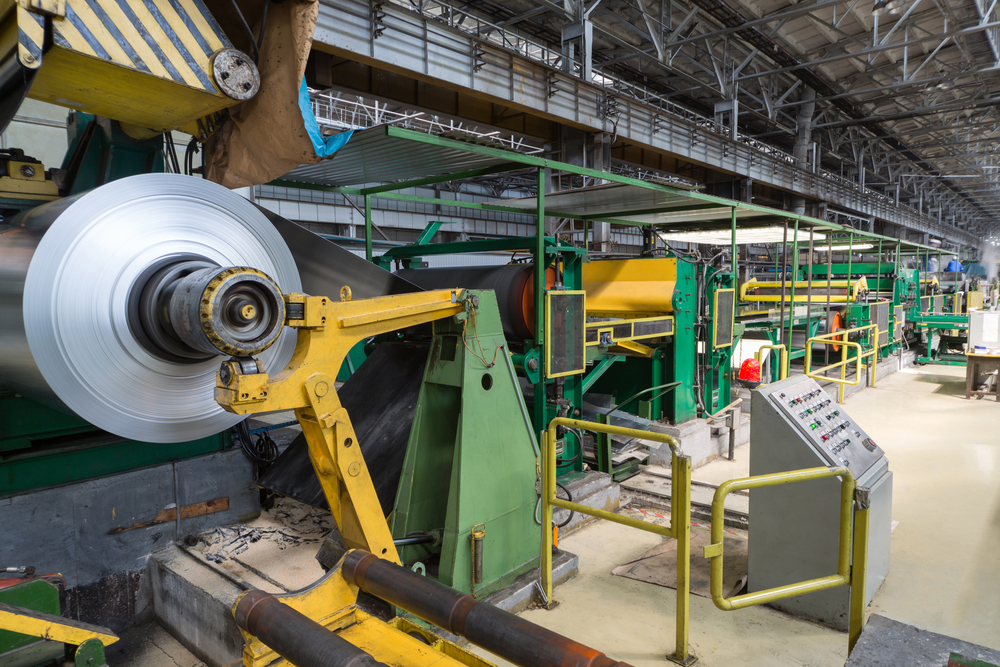INTRODUCTION
Achieving a surface that meets stringent quality and performance standards is critical in the manufacture of stainless steel. During annealing and hot rolling, oxide layers are formed on the surface of stainless steel. Beneath these oxide layers, chromium is depleted, significantly reducing the corrosion resistance of the steel. To restore the integrity of the material, it is essential to remove these oxides and replenish the chromium-depleted areas.
Chemical cleaning by pickling is the most effective method of removing oxide scale and provides the best results in terms of surface quality and corrosion resistance. The pickling process typically uses acid mixtures containing hydrofluoric acid (HF) and nitric acid (HNO₃) to dissolve the oxides and prepare the steel surface for further processing. This article provides a detailed overview of the chemical reactions involved in the pickling process and discusses the environmental challenges associated with traditional neutralization methods. It also presents SUSTEC's REGMAX process as a sustainable solution for waste acid regeneration.
PICKLING WITH NITRIC AND HYDROFLUORIC ACID
Nitric acid is a potent oxidizing agent; however, it is not an effective standalone solution for pickling stainless steel due to its inability to fully dissolve the passive oxide layer. However, when combined with hydrofluoric acid, the mixture becomes highly effective. This combination is not only effective but also delivers the best results in terms of surface quality and corrosion resistance. The combination of HNO₃ and HF allows for precise control of the pickling rate to be achieved by adjusting the ratio of the two substances. In this combination, the nitric acid (HNO₃) acts as an oxidizing agent, dissolving metal oxides and the underlying metal. The hydrofluoric acid (HF) forms stable complexes with metal ions, aiding in their removal from the surface. This dual action ensures efficient oxide removal and restoration of the chromium content on the steel surface, making this method the preferred one in the industry.
REACTION MECHANISM FOR IRON
The pickling process entails a series of chemical reactions, notably those involving iron, a principal component of stainless steel. The simplified reaction mechanisms are as follows:
Initial Dissolution of Iron:
(1) 2 Fe + 2 HNO3 + 4 H+ → 2 Fe2+ + 2HNO2 + 2 H2O
The oxidation of ferrous ions to ferric ions is as follows:
(2) 2 Fe2+ + HNO3 + 2H+ → 2 Fe3+ + HNO2 + H2O
Decomposition of nitrous acid:
(3) 2 HNO2 → NO + NO2 + H2O
The formation of iron fluoride complexes: The reaction between ferric ions and fluoride ions results in the formation of stable iron fluoride complexes, as evidenced by the following equation:
(4) Fe3 + 3F– → FeF3
The three valent iron will form a stable complex with the fluorides. The types of formed fluoride complexes are depending on the pickling process conditions.
Nickel, another constituent of stainless steel, primarily reacts with nitric acid, resulting in the following equilibrium reactions:
Ni+2 + HNO3 ⇌ Ni(NO3)2 + H2O
Ni+2 + HNO3 ⇌ Ni(NO3)2 + H2O
ENVIRONMENTAL & ECONOMICAL IMPACT OF STAINLESS PICKLING
As described above, the pickling process transforms portions of the acids into metal salts, including those of chromium, nickel, and iron. The traditional method for neutralizing spent acid involves the use of alkaline substances, such as calcium hydroxide, which results in the production of significant quantities of toxic sludge containing metal hydroxides. This practice presents a number of environmental and operational challenges.
The generation of toxic sludge: The sludge must be disposed of correctly, which contributes to environmental pollution and results in high waste management costs. If not handled correctly, the toxicity of the sludge presents a significant risk.
Inefficient use of resources: The waste stream contains valuable metals and acids, representing a missed opportunity for resource recovery and resulting in a continuous need to purchase fresh acids.
High operational costs: The continuous purchase of acids and neutralizing agents, along with waste disposal expenses, increases production costs.
Regulatory Pressure: Environmental authorities are imposing stricter regulations on waste disposal, particularly concerning nitrates and heavy metals in effluents. Companies risk losing their operation licenses if sustainable solutions are not implemented, with a preference for technologies like SUSTEC's REGMAX.
Dependency on Raw Materials: The production chain of hydrofluoric and nitric acids is complex and energy-intensive, leading to significant greenhouse gas emissions and making producers reliant on consistent acid supplies.
LIMITATIONS OF ALTERNATIVE PICKLING METHODS
Attempts to mitigate the described environmental and economic impact have included:
Purification Processes: These processes may reduce acid consumption and offer economic benefits by recycling some of the acids back into the pickling process. However, they do not change the amount of waste generated, nor do they address the underlying environmental problems. The toxic sludge production remains unchanged, continuing to pose disposal challenges and environmental risks.
Replacement of Nitric Acid with Sulfuric Acid: Some have explored replacing nitric acid with sulfuric acid (H₂SO₄) to alleviate nitrate emissions. However, this approach merely shifts the environmental burden from nitrate emissions to sulfate emissions. In regions where this shift occurred due to nitrate emission limits, companies now face regulatory pressure due to sulfate emission limits, placing them under scrutiny once again. This strategy does not solve the environmental impact but exchanges one pollutant for another.
These alternatives have not provided comprehensive solutions to the environmental and economic challenges posed by traditional neutralization methods. A complete and sustainable solution to recycle the pickling waste being the only way to solve the environmental problem of stainless steel pickling
STAINLESS PICKLING WITH REGMAX TECHNOLOGY
To address these described challenges, SUSTEC has developed the REGMAX process, an innovative technology for the complete regeneration of spent acids, including metals. The REGMAX process enables complete acid regeneration by recovering both hydrofluoric and nitric acid from the spent pickling solution, creating a closed loop system that minimizes the need to purchase fresh acid. This ensures that the best pickling conditions are maintained without compromising the environment.
In addition to acid recovery, the REGMAX process facilitates metal recovery. Valuable metals such as iron, nickel and chromium are recovered from the waste acid and can be returned to the production process. This not only conserves resources but also reduces the toxicity of the remaining waste.
By regenerating acids and recovering metals, the process dramatically reduces the volume of toxic sludge to be disposed of to almost zero, thereby reducing environmental impact and compliance risks. Reduced expenditure on acids and neutralizing agents, combined with the lowest waste management costs, results in significant operational savings.
In addition, the REGMAX process helps manufacturers meet stringent environmental regulations by minimizing hazardous waste and reducing emissions associated with acid production and waste disposal. It addresses the regulatory pressures associated with operating licenses by providing a sustainable solution. By promoting resource efficiency and waste minimization, the process contributes to the sustainability goals of the stainless-steel industry (green steel), in line with global efforts to reduce environmental impact.
CONCLUSION
Pickling of stainless steel is a critical process that ensures the corrosion resistance and surface quality of the material. Traditional pickling methods using hydrofluoric and nitric acids are highly effective and provide the best results in terms of surface quality and corrosion resistance. However, they have significant environmental and economic drawbacks due to the generation of toxic sludge, waste water and resource inefficiency. Conventional neutralization processes exacerbate these problems by generating hazardous waste and consuming large quantities of neutralizing agents.
Purification processes and the replacement of nitric acid with sulphuric acid have failed to provide sustainable solutions, often simply shifting the environmental burden from one area to another without addressing the core issues. This has led to increased regulatory pressure, with stainless steel producers facing challenges in maintaining operating licenses if sustainable solutions are not implemented.
SUSTEC's REGMAX process provides a comprehensive and sustainable solution by enabling the complete regeneration of waste acids and recovery of valuable metals, effectively closing the acid loop in stainless steel pickling. This innovative approach transforms the pickling process into a sustainable system that complies with environmental regulations, reduces operating costs and maintains optimal pickling conditions without compromising quality.
By adopting the REGMAX process, stainless steel producers can improve their competitiveness while helping to protect the environment. Producers are encouraged to integrate this technology into their operations to achieve optimal results and ensure compliance with evolving environmental standards. This forward-looking solution represents a significant step towards a more sustainable and responsible stainless-steel industry.
"SUSTEC's REGMAX process enables total waste acid regeneration, including metals, facilitating a closed acid loop for stainless steel pickling. "

